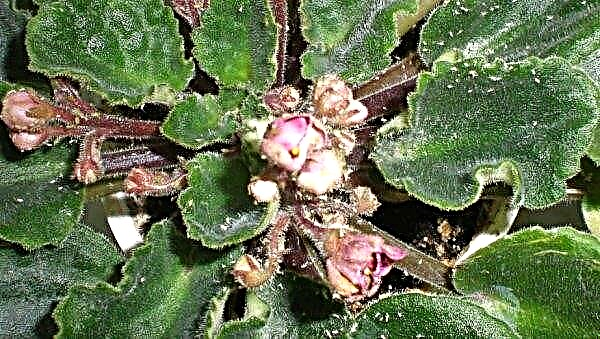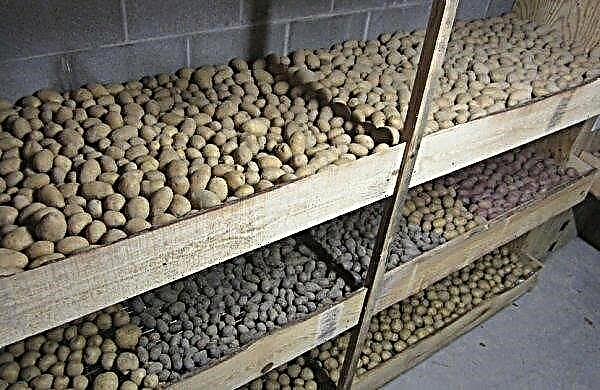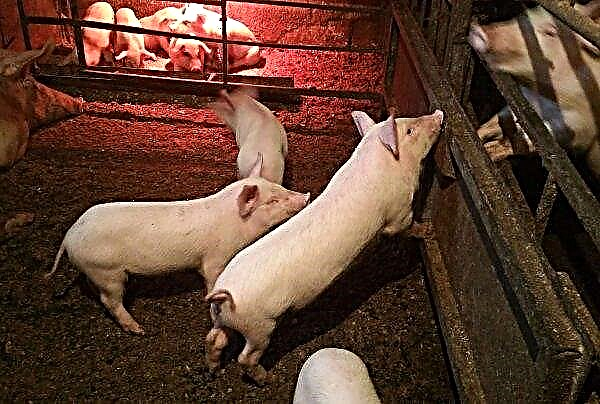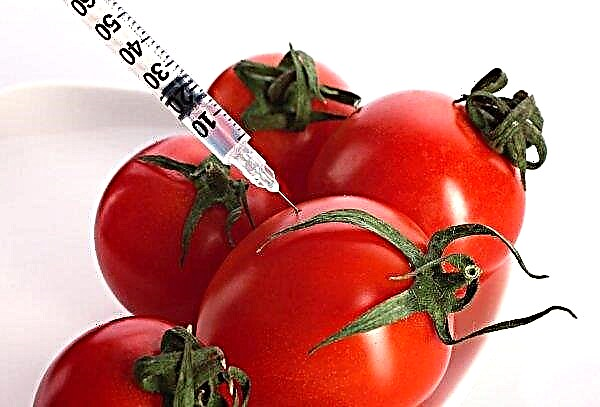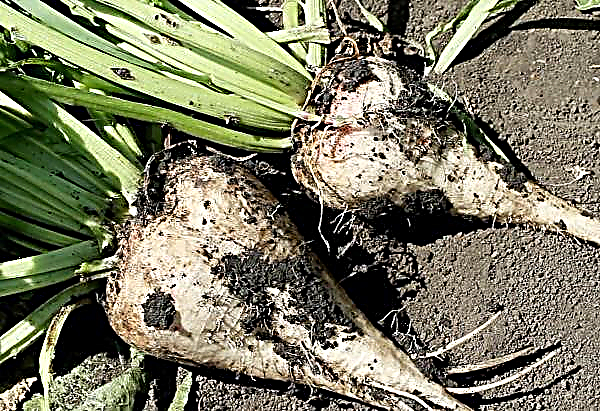Owners of cattle farms often encounter such a dangerous infectious disease as salmonellosis in their practice. In most cases, young individuals suffer from the disease, but it is possible that adults, in whom the disease is asymptomatic, can also be affected. What is dangerous salmonellosis and how to treat it, let's figure it out.
What is this disease
Salmonellosis is an acute infectious disease that affects almost all farm animals and is accompanied by the presence of fever and an upset digestive tract. In severe cases, the disease can affect the respiratory system, including the lungs.
A person may also become infected with the disease in question. The causative agent of salmonellosis is the bacterium Salmonella from the Enterobacteriaceae family of bacteria.
Most often, salmonellosis affects young animals, which are grown under conditions that do not meet sanitary standards. Poor nutrition, unsanitary conditions lead to the fact that animals have reduced immunity and they become susceptible to various infections.
In calves, body temperature rises, fever, digestive upset occurs, and with an acute form, the lungs are affected.
History reference
Paratyphoid, or salmonellosis, is caused by a bacterium called Salmonella, named after the eponymous veterinarian Salmon, who, together with the biologist Smith in 1885, isolated a pathogenic bacillus from the biological material of dead pigs. A few years later, similar bacteria were found in calves, mice, chickens.
In 1934, representatives of the International Society of Microbiologists proposed to combine all the bacteria of this group with one name - “salmonella”, and to call the ailment “salmonella”. The disease is widespread throughout the world, including post-Soviet countries.
Important! Distributors of the sticks are mainly mature individuals that are able to transmit the infection to animals of a kind, other species, and even to humans.
Economic damage
If he does not take all the necessary measures to eliminate the disease in time, he is able to bring huge financial losses to agriculture. The main danger of the disease is that it is quickly transmitted from animal to animal, affecting the entire herd.
According to statistics, the death rate of young animals in piglets is from 50 to 70%, in lambs - 40–50%, and in fur animals this indicator varies between 60–70%. As you can see, with the spread of paratyphoid bacteria, more than half of the total number of livestock, including calves in cattle, can die.
Pathogen and causes of infection
The causative agents of salmonellosis are Salmonella bacteria of various types. In fact, they are all similar to each other: they visually resemble small rod-shaped organisms with rounded edges, the length of which reaches 1–4 μm, the width is about 0.5 μm. They do not form spores and capsules. Salmonella belong to gram-negative microorganisms, can be stained with aniline dyes.
They do not form spores and capsules. Salmonella belong to gram-negative microorganisms, can be stained with aniline dyes.
It should be noted that the most comfortable conditions for the propagation of pathogenic bacteria is considered to be a temperature of +37 ° C and above, as well as a nutrient medium in the range of 7.2–7.6 pH. In turn, bacteria can tolerate freezing for a period of 3-4 months, and in organic waste (manure, feces) can persist for months.
Pathogenic microorganisms die at a temperature range of + 70–75 ° С for 15–30 minutes. Disinfectant solutions of sodium hydroxide, active chlorine, iodine, and freshly slaked lime help get rid of the pathogen.
In most cases, an illness in calves is recorded in the spring, during calving. The main cause of infection is considered to be a significant decrease in calf immunity and a deterioration in the body's overall resistance to various bacteria and viruses.
This is due to a lack of vitamin-mineral components in the diet, adverse living conditions, etc. The disease is particularly dangerous for young animals aged 10 to 60 days.
The first bacteria to infect weak, physically underdeveloped calves or individuals with developmental pathologies. Infection is carried out by feeding calves with mother’s milk, which is the carrier of the bacteria.
If you do not take measures to eliminate the disease, then after 2-3 weeks the entire stock of young animals, despite good physical data, may die. Salmonella viruses can tolerate drying for a long time. That is why infected household items, for example, rakes, pitchforks, as well as pens contaminated with waste from sick animals, have been sources of infection for a very long time.Important! Calves that have been ill with salmonellosis acquire immunity, but continue to transfer the disease through saliva, feces, etc.

Pathogenesis
The first organ that is affected by salmonella is the intestines. It is getting into it through the oral cavity that microorganisms begin to multiply intensively, and the first symptoms of the disease appear in the animal.
If the calf's immune system is in order, then the bacterium does not have the strength to break through the lymph or blood, and is excreted through feces without causing harm. Otherwise, salmonella enters the bloodstream, spreads to all organs and, thus, leads to the appearance of paratyphoid septicemia.
Active reproduction of bacteria leads to the fact that they begin to secrete endotoxins, which in large volumes become a real poison for calves.
This period is considered the most dangerous, since exudative changes that occur in the circulatory system lead to red blood cell diapedesis, more simply, bleeding, as well as damage to the mucous membranes and serous integuments.
Symptoms and course of the disease
There are several degrees of salmonella infection: acute, or severe, subacute and chronic. However, the symptoms in all three are almost identical. The incubation period, from the defeat by bacteria to the onset of characteristic symptoms, is 1-3 days.
When exposed to physically strong individuals, the incubation period can last up to a week.
Spicy
The onset of the disease is characterized by a sharp increase in temperature, which reaches 40–41 ° C. Against the background of elevated temperature, the animal has problems with the functioning of the cardiovascular system: the heart rate increases to 150 beats per minute, arrhythmia, heavy breathing, shortness of breath occur.
In addition, signs of serous conjunctivitis are manifested: lacrimation, purulent rhinitis.
After a few days, bowel problems appear. In feces, clots of mucus with vesicles can be found, later bloody spots with an unpleasant, rather sharp smell appear. After damage to the intestine, the stage of damage to the kidneys and urogenital system occurs.
Urination becomes more frequent in the calf; it becomes very painful. Protein is present in the urine, red blood cells and other substances that are not characteristic of the normal composition appear. In the absence of treatment after 5-10 days, the animal loses weight and eventually dies.
The subacute form of salmonellosis manifests itself with similar symptoms, but they are slightly weaker. The animal rises in temperature, diarrhea and conjunctivitis begins, there are no obvious signs of a violation of the genitourinary system, but there are signs of lung infection, wheezing, vesicular panting are heard.
Chronic course
The chronic course of the disease, as a rule, is the result of an untreated form of acute or subacute infection. In this case, the symptoms are more reminiscent of pneumonia than the presence of salmonella pathogenic bacillus in the body. Among the symptoms of chronic salmonellosis are noted:
Among the symptoms of chronic salmonellosis are noted:
- dry and rare cough, which subsequently turns into a moist, lingering and painful for the calf;
- mild diarrhea that stops quickly;
- rhinitis, gradually turning into an acute form;
- joint inflammation;
- the development of pneumonia;
- groans of the animal, throwing his head back.
At the same time, wheezing is heard in the lungs of the animal, breathing becomes heavy. This form of the disease can last up to two months, and if young animals are not treated during this time, then the probability of its death is high.
Did you know? Salmonella is extremely resistant to various external factors. It perfectly withstands freezing, actively reproduces at room temperatures, can freely penetrate through the eggshell, live up to one month in fermented milk products. Surprisingly, even smoking and salting can not effectively cope with the bacterium and act only at a salt concentration of at least 18%.
Diagnostics
Diagnosis of salmonellosis in calves is carried out using laboratory tests of feces, urine and blood. In this case, the final diagnosis is determined by the veterinarian taking into account complex methods: the results of bacteriological and serological tests, the overall clinical picture, the condition of the animal, and external signs.
Through such a diagnosis, the likelihood of contracting other dangerous infections, in particular dyspepsia, enteritis, is eliminated. For an accurate diagnosis of a dead animal, samples of the liver, spleen, lungs, kidneys, and lymph nodes are taken for analysis.
For an accurate diagnosis of a dead animal, samples of the liver, spleen, lungs, kidneys, and lymph nodes are taken for analysis.
Pathological changes
At a pathological examination, it is quite simple to detect signs of salmonellosis, since the disease is characterized by intestinal and septic abnormalities. The spleen undergoes drastic changes: it acquires a grayish-red, sometimes almost black shade, rounded at the edges and enlarged.
The gastric mucosa is quite swollen, reddened, with clear hemorrhages in the folds. Lesions can also be found on the small and large intestines, which form hemorrhages in the form of dots or stripes. An untouched liver can indicate an acute course of the disease.
In the lungs, excessive hyperemia or severe edema can be detected, which, in most cases, are symptoms of catarrhal bronchial pneumonia.
How to treat
Timely provision of medical care will avoid the death of cattle herds and achieve complete recovery of animals from salmonellosis.
Treatment is carried out in a complex and is aimed primarily at:
- suppression of bacteria in the body of the affected animal;
- relieving symptoms of body poisoning;
- restoration of the normal functioning of the digestive system.

General recommendations
Before starting the therapeutic and medical treatment of diseased calves, a number of organizational measures are performed:
- isolate a sick animal in a separate room;
- provide the calf with special diet food;
- create a comfortable microclimate in the room (with a certain temperature, humidity level, good ventilation);
- add vitamins and minerals to the cattle diet, which are necessary to increase immunity.
Polyvalent Antitoxic Serum
In the early days of treatment, it is recommended to use a polyvalent antitoxic serum specially developed on the basis of immunoglobulins and antitoxins of healthy individuals, which is used in conjunction with antibiotic drugs of the tetracycline group. It allows you to form a passive immunity to the causative agent of the disease.
The introduction of the drug is carried out intramuscularly or intravenously in such dosages:
- animal age up to 10 days - 5-10 cubic meters. cm serum;
- calves from 10 to 30 days old - 20 cubic meters. cm.
The serum is most effective if its daily dose is divided into 3-4 doses. In this case, the serum itself makes it possible to neutralize the action of bacteria, and antibiotics - to prevent the development of pneumonia.
Antibiotics and sulfa drugs
One of the best methods for treating calf salmonellosis is the use of antibiotics and sulfa drugs.
Important! Before the introduction of any type of antibiotic, it is imperative to check the reaction of the animal to it.
In most cases, chloramphenicol is used, which is given in a dosage of 0.04 g per 1 kg of mass. Before use, the product is diluted with water and fed to calves three times a day. The duration of such treatment is 2-3 days.
It is also advisable to use tetracycline, which is given in a dose of 0.02 g per 1 kg of body weight, or synthomycin in a dosage of 0.02-0.04 g per 1 kg of body weight.
Antibiotics paired with sulfonamide drugs (norsulfazole, sulcimide and others) have good efficacy in the fight against salmonella of various types. The latter are especially effective in the treatment of a chronic form of the disease, since they prevent the development of pneumonia.
In this case, the dose of such drugs in the first day should be at least 0.1 g per 1 kg of weight.
Nitrofuran preparations
In veterinary practice, for the treatment of salmonellosis, nitrofuran series preparations are often used, among which furazonal and furacron can be noted.
Did you know? About 200,000 people die from typhoid fever, which is caused by the S. Typhi Salmonella strain, every year.
The preparations are mixed with milk of 0.25 g each and calves are fed in the morning, lunch and evening.
Salmonella Vaccine
Of course, the best specific prophylaxis of salmonellosis is animal vaccination. As a vaccine, several types of drugs are used, in particular, for calves, a concentrated formolvac vaccine is considered the best option.
Vaccination is carried out already from the first 2–3 days of the animal’s life. The drug is administered under the skin, in the neck. After 3-5 days, the procedure is repeated.
It is especially important to vaccinate pregnant cows on time. They are administered the drug in two doses, with an interval between injections of 8-10 days. The first time using 10 cubic meters. see funds, in the second - 15 cubic meters. see Vaccination of pregnant heifers is carried out 50-60 days before the expected date of calving.
The drug is effective for about six months, after which it is necessary to conduct repeated injections.
Salmonellosis vaccine is recommended to be purchased only in specialized stores, veterinary pharmacies, as well as apply and store it exclusively according to the instructions.
Important! The vaccine gives immunity to salmonella not instantly, but 10-12 days after administration.
General preventive measures
It should be noted that the treatment of salmonellosis is quite difficult and lengthy, so it is much easier to prevent the development of the disease. And for this it is recommended to observe some preventive measures:
And for this it is recommended to observe some preventive measures:
- strictly follow the veterinary and sanitary rules for keeping animals;
- regularly treat the premises with disinfectants;
- prevent the accumulation of waste products in pens where cattle are kept;
- conduct competent picking of the herd;
- provide cows with a full, balanced vitamin and mineral nutrition;
- monitor the water balance of animals;
- conduct an active fight against rodents and other pests in premises with cattle;
- prevent the entry of the causative agent of the disease from the outside;
- quickly isolate infected individuals from the general herd;
- conduct timely vaccination.
In fact, if you follow the rules of cattle, regarding, in particular, proper nutrition and comfortable living conditions, then the likelihood of developing salmonella can be reduced to almost zero.
However, even with infection of animals, the most important thing is to provide them with qualified treatment in time, and thereby avoid the harmful effects of the disease.


